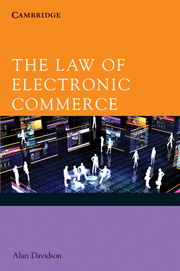Book contents
- Frontmatter
- Contents
- Acknowledgements
- Table of Cases
- Table of statutes
- 1 The law of electronic commerce
- 2 The rule of cyberspace
- 3 Electronic commerce and the law of contract
- 4 Shrinkwrap, clickwrap and browsewrap contracts
- 5 Electronic signatures
- 6 Copyright issues in electronic commerce
- 7 Electronic commerce – trade marks, patents and circuit layouts
- 8 Domain names
- 9 Domain name disputes
- 10 Uniform domain name dispute resolution policies
- 11 Jurisdiction in cyberspace
- 12 Defamation in cyberspace
- 13 Privacy and data protection in cyberspace
- 14 Electronic mail and online presence
- 15 National electronic surveillance
- 16 Cybercrime
- 17 Evidence of electronic records
- 18 Censorship – Broadcast and online content regulation
- 19 An international perspective
- Appendix A Electronic Transactions (Victoria) Act 2000
- Appendix B UNCITRAL Model Law on Electronic Commerce
- Appendix C Selected provisions Copyright Act 1968 (Cth)
- Appendix D ICANN Uniform Dispute Resolution Policy (UDRP)
- Appendix E .au Dispute Resolution Policy (auDRP)
- Appendix F National Privacy Principles
- Index
- References
16 - Cybercrime
Published online by Cambridge University Press: 05 June 2012
- Frontmatter
- Contents
- Acknowledgements
- Table of Cases
- Table of statutes
- 1 The law of electronic commerce
- 2 The rule of cyberspace
- 3 Electronic commerce and the law of contract
- 4 Shrinkwrap, clickwrap and browsewrap contracts
- 5 Electronic signatures
- 6 Copyright issues in electronic commerce
- 7 Electronic commerce – trade marks, patents and circuit layouts
- 8 Domain names
- 9 Domain name disputes
- 10 Uniform domain name dispute resolution policies
- 11 Jurisdiction in cyberspace
- 12 Defamation in cyberspace
- 13 Privacy and data protection in cyberspace
- 14 Electronic mail and online presence
- 15 National electronic surveillance
- 16 Cybercrime
- 17 Evidence of electronic records
- 18 Censorship – Broadcast and online content regulation
- 19 An international perspective
- Appendix A Electronic Transactions (Victoria) Act 2000
- Appendix B UNCITRAL Model Law on Electronic Commerce
- Appendix C Selected provisions Copyright Act 1968 (Cth)
- Appendix D ICANN Uniform Dispute Resolution Policy (UDRP)
- Appendix E .au Dispute Resolution Policy (auDRP)
- Appendix F National Privacy Principles
- Index
- References
Summary
The advance of information technology and computer technology has led to a corresponding increase in computer crime. There is no accepted definition of computer crime. Computers may be the subject of a crime, such as theft, or a computer may be used to commit a crime. Typically a computer is used, or misused, to elicit or manipulate data or processing. Simple unlawful access to a computer system can be regarded as an offence. Telecommunications may be involved. The result may be a transfer of funds or of confidential information. Sending an email to place a virus can be unlawful. The free flow of information has generated undesirable and abhorrent material. The public has expressed concern about pornography, information on how to make bombs and information about suicide techniques. New offences have been created in response to these concerns. Persons gaining unlawful access to computers for these purposes are typically referred to as crackers: hackers with malicious intent. Many crimes that are not specifically related to computers can be substantially facilitated by the use of computers. Crimes involving electronic commerce typically involve the use of computers and telecommunications. This area is often referred to as cybercrime.
In surveys undertaking by the Australian Computer Emergency Response Team (AusCERT), the most common breaches involved viruses (programs or codes that can replicate themselves and infect computers without the owner's consent and often without the owner's knowledge), worms (programs or codes which replicate themselves using a network system, and that are designed to cause malicious damage) and Trojan infections (code incorporated into an existing program which gives the appearance of performing a desirable function but which performs malicious functions).
- Type
- Chapter
- Information
- The Law of Electronic Commerce , pp. 267 - 295Publisher: Cambridge University PressPrint publication year: 2009

